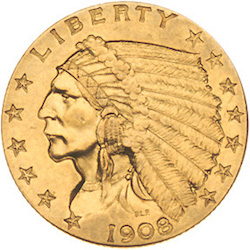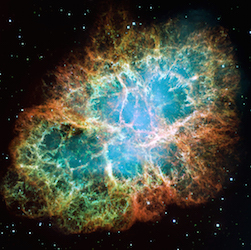Where did gold come from?
 We know that coins are often made out of materials such as gold, silver, and platinum.
But why does the Earth contain such materials?
As I'm sure you remember from your astrophysics course in college, stars generate energy by nuclear fusion. In the
core of the Sun, hydrogen nuclei are fused into helium nuclei, releasing energy in the process. In more mature stars
(such as red giants) helium may fuse into carbon, carbon into oxygen, etc. This explains the origin of elements as
heavy as iron. The problem with iron is that energy cannot be generated through nuclear fusion. In order to fuse
iron into heavier elements, it would require energy -- and lots of it.
We know that coins are often made out of materials such as gold, silver, and platinum.
But why does the Earth contain such materials?
As I'm sure you remember from your astrophysics course in college, stars generate energy by nuclear fusion. In the
core of the Sun, hydrogen nuclei are fused into helium nuclei, releasing energy in the process. In more mature stars
(such as red giants) helium may fuse into carbon, carbon into oxygen, etc. This explains the origin of elements as
heavy as iron. The problem with iron is that energy cannot be generated through nuclear fusion. In order to fuse
iron into heavier elements, it would require energy -- and lots of it.
The source of elements heavier than iron
 The only naturally occurring event with enough energy to fuse heavier elements together is a supernova. When
stars
develop iron cores (which the Sun will never do), the core collapses and heats. The energy gets trapped inside until
the entire star explodes as a supernova. During the explosion all elements heavier than iron are created. If there
were no exploding stars in the universe, we would have no gold, silver, or platinum for our coins.
Long ago some supernovae spewed material into space. Some of that material went into forming the sun and solar
system. All of the elements heavier than iron that are now part of the Earth originated from those supernovae.
The only naturally occurring event with enough energy to fuse heavier elements together is a supernova. When
stars
develop iron cores (which the Sun will never do), the core collapses and heats. The energy gets trapped inside until
the entire star explodes as a supernova. During the explosion all elements heavier than iron are created. If there
were no exploding stars in the universe, we would have no gold, silver, or platinum for our coins.
Long ago some supernovae spewed material into space. Some of that material went into forming the sun and solar
system. All of the elements heavier than iron that are now part of the Earth originated from those supernovae.
Remember, stars exploded so that we may have coins.
Image credit: The crab nebula image was created for NASA by Space Telescope Science Institute and for ESA by the Hubble European Space Agency Information Centre under Contract NAS5-26555